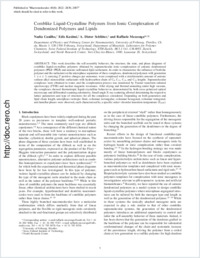Comblike liquid-crystalline polymers from ionic complexation of dendronized polymers and lipids
- Canilho, Nadia Department of Physics and Fribourg Center for Nanomaterials, University of Fribourg, Switzerland
- Kasëmi, Edis Department of Materials, Laboratory for Polymer Chemistry, Swiss Federal Institute of Technology, ETH-Zurich. Switzerland
- Schlüter, Dieter A. Department of Materials, Laboratory for Polymer Chemistry, Swiss Federal Institute of Technology, ETH-Zurich. Switzerland
- Mezzenga, Raffaele Department of Physics and Fribourg Center for Nanomaterials, University of Fribourg, Switzerland - Nestlé Research Center, Vers-Chez-les-Blancs, Lausanne, Switzerland
-
15.03.2007
Published in:
- Macromolecules. - 2007, vol. 40, no. 8, p. 2822 -2830
English
This work describes the self-assembly behavior, the structure, the state, and phase diagrams of comblike liquid-crystalline polymers obtained by supramolecular ionic complexation of cationic dendronized polymers (PG1-PG3) and anionic sulfonated lipid surfactants. In order to characterize the influence of both the polymer and the surfactant on the microphase separation of these complexes, dendronized polymers with generation 1 ≤ n≤ 3, carrying 2ⁿ positive charges per monomer, were complexed with a stoichiometric amount of anionic sodium alkyl monosulfate surfactants with hydrocarbon chain of C₈, C₁₂, C₁₄, and C₁₈ lengths. Supramolecular complexes were obtained in water, and the complexation process was monitored by Fourier transform infrared spectroscopy (FTIR) and nuclear magnetic resonance. After drying and thermal annealing under high vacuum, the complexes showed thermotropic liquid-crystalline behavior as demonstrated by both cross-polarized optical microscopy and differential scanning calorimetry. Small-angle X-ray scattering allowed determining the respective lattice parameters and type of structures for all the complexes considered. Depending on both generation and lipid chain length, amorphous isotropic fluid, columnar rectangular, columnar hexagonal, columnar tetragonal, and lamellar phases were observed, each characterized by a specific order-disorder transition temperature (TODT).
- Faculty
- Faculté des sciences et de médecine
- Department
- Département de Physique
- Language
-
- English
- Classification
- Chemistry
- License
- License undefined
- Identifiers
-
- RERO DOC 8848
- DOI 10.1021/ma062941n
- Persistent URL
- https://folia.unifr.ch/unifr/documents/300571
Statistics
Document views: 68
File downloads:
- canilho_clc.pdf: 133
